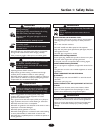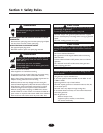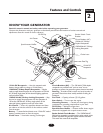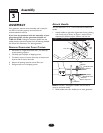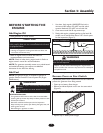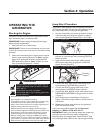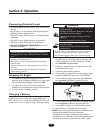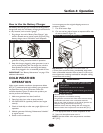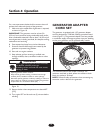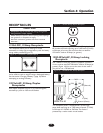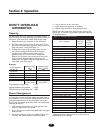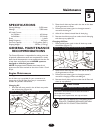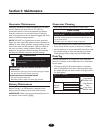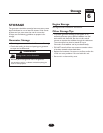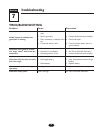
11
How to Use the Battery Charger
Use battery float charger jack to keep the starting battery
charged and ready for use. Battery charging should be done
in a dry location, such as inside a garage.
1. Plug charger into unit’s “Battery Float Charger” jack,
which is located next to starter switch (Figure 9). Plug
battery charger into a 120Volt AC wall receptacle.
2. Unplug charger from unit and wall outlet when
generator is being started and while in operation.
3. Keep this charger plugged in when generator is not in
use to prolong battery life.The charger has a built in
float equalizer and will not overcharge the battery,
even when plugged in for an extended period of time.
IMPORTANT: See “Battery Maintenance” on page 15 for
additional information.
COLD WEATHER
OPERATION
Under certain weather conditions (temperatures below
40°F [4°C] combined with high humidity), your generator
may experience icing of the carburetor and/or the
crankcase breather system.To reduce this problem, you
need to perform the following:
1. Make sure generator has clean, fresh fuel.
2. Open fuel valve (turn valve to open position).
3. Use SAE 5W-30 oil (synthetic preferred, see engine
manual).
4. Check oil level daily or after every eight (8) hours of
operation.
5. Maintain generator following “Maintenance Schedule”
in engine manual.
6. Shelter unit from elements.
In an emergency, use the original shipping carton as a
temporary shelter:
7. Cut off all carton flaps.
8. Cut out one long side of carton to expose muffler side
of unit as shown in Figure 10.
IMPORTANT: The generator must be at least 5 ft.
(152 cm) from structures having combustible walls and/or
other combustible materials. Leave at least 3 ft. (92 cm) all
around generator including overhead, for adequate cooling,
maintenance and servicing.
9. Cut appropriate slots to access receptacles of unit.
10. Start unit, then place carton over it.
NOTE: Remove shelter when temperatures are above
40°F [4°C].
Figure 10 — Permanent Cold Weather Shelter
Wind
Section 4: Operation
Figure 9 — Battery Charger Jack
• DO NOT touch hot surfaces.
• Allow equipment to cool before touching.
• The generator must be at least 5 feet from structures having
combustible walls and/or other combustible materials.
• Keep at least 3 feet of clearance on all sides of generator for
adequate cooling, maintenance and servicing.
• Reflective exhaust heat may damage fuel tank causing fire.
• Remove shelter when temperatures are above 40°F [4°C].
Running engines produce heat.Temperature of
muffler and nearby areas can reach or exceed
150°F (65°C).
Severe burns can occur on contact.
Combustible debris, such as leaves, grass, brush,
etc. can catch fire.
WARNING



